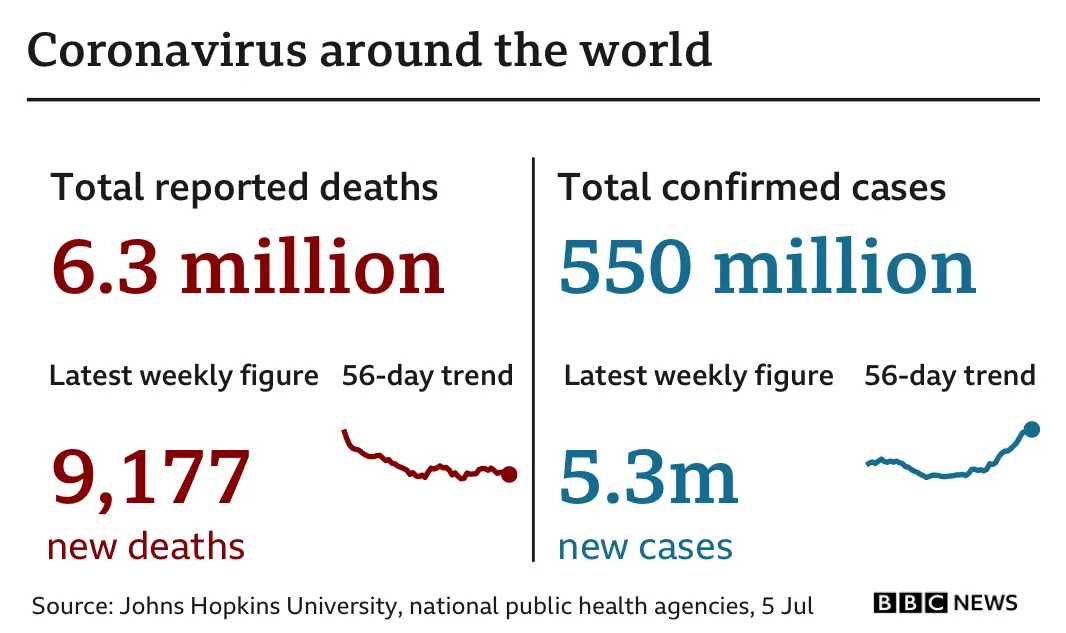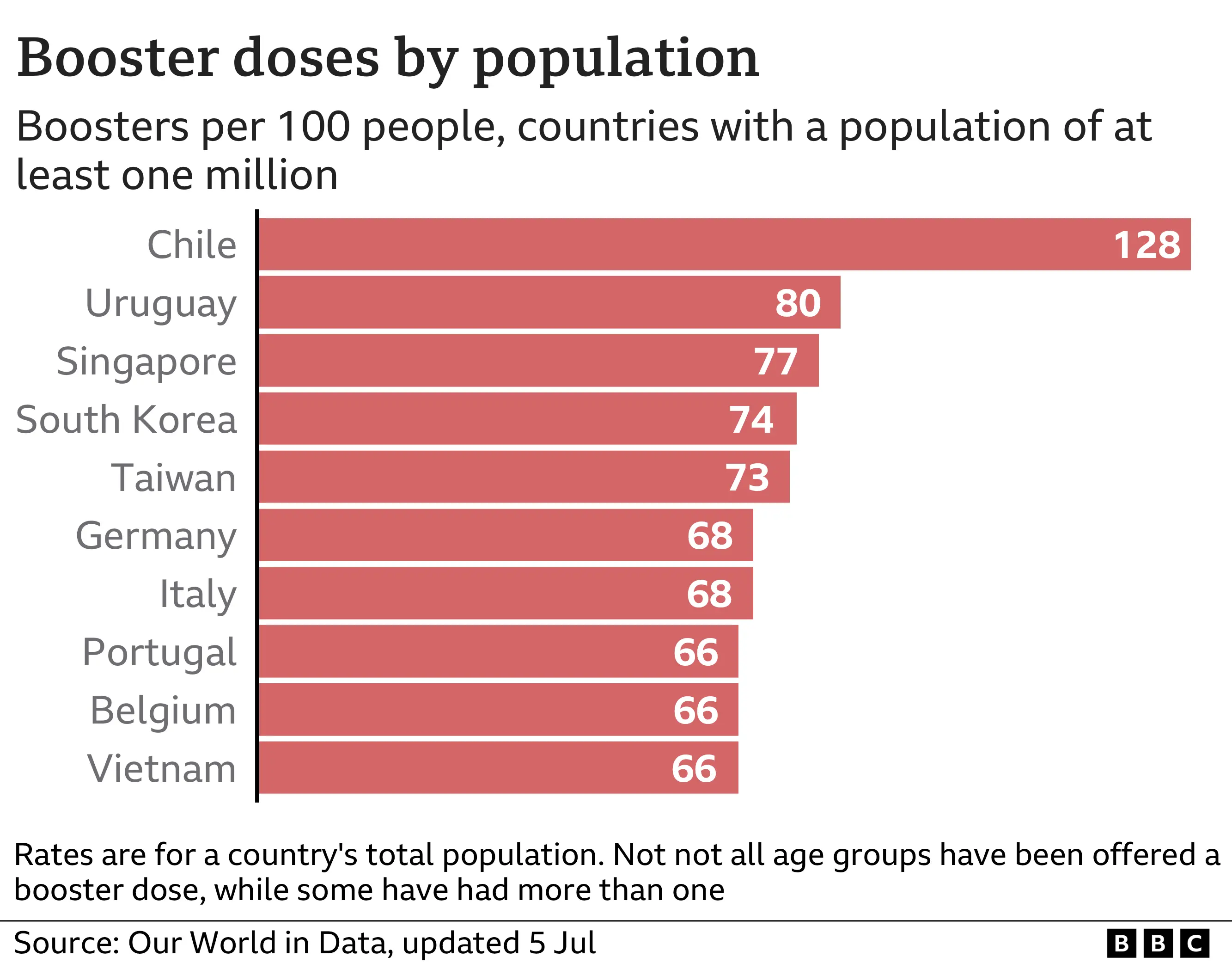Covid map: Coronavirus cases, deaths, vaccinations by country
 Reuters
ReutersCovid-19 is continuing to spread around the world, with more than 550 million confirmed cases and more than six million deaths reported across almost 200 countries.


The US, India and Brazil have seen the highest number of confirmed cases, followed by France, Germany and the UK.
Very few places have been left untouched.

In the table below, countries can be reordered by deaths, death rate and total cases. In the coloured bars on the right-hand side, countries in which cases have risen to more than 10,000 per day are those with black bars on the relevant date.

The true extent of the first outbreak in 2020 is unclear because testing was not then widely available.
Deaths are falling in many areas, however official figures may not fully reflect the true number in many countries.
Data on excess deaths, a measure of how many more people are dying than would be expected based on the previous few years, may give a better indication of the actual numbers in many cases.
Using this metric, researchers from the Lancet medical journal suggest that more than 18 million people may have died because of Covid up to the end of 2021. That figure is three times higher than officially recorded deaths from the disease.
Separate analysis by the World Health Organization (WHO) estimates about 15 million excess deaths due to coronavirus over a similar period.


Who has vaccinated the most?
Nearly every nation in the world is now administering vaccines and publishing rollout data, while at least 157 countries and territories have moved on to booster jabs.
The map below, using figures collated by Our World in Data - a collaboration between Oxford University and an educational charity - shows the total number of doses given per 100 people, mostly first doses.
According to that data, more than 64% of people have been fully vaccinated on every continent apart from Africa, where the figure is about 20%.

Some countries have secured more vaccine doses than their populations need, while other lower-income countries are relying on a global plan known as Covax, which is seeking to ensure everyone in the world has access to a vaccine.
Of those countries that have moved on to booster campaigns, Chile, Uruguay and Singapore have currently vaccinated the highest proportion of people.


Where are cases still high?
Daily global cases fell after a spike in the spring but are now rising again, with the emergence of the BA.4 and BA.5 subvariants of the Omicron variant.
Studies suggest that Omicron - which quickly became dominant in numerous countries - is milder than the Delta variant, but far more contagious. The subvariants are even more contagious.

Asia
Asia, which was the centre of the initial outbreak that spread from Wuhan in China in early 2020, shows a mixed picture.
North Korea, which admitted its first Covid infections in May of this year, has now seen 4.75 million symptomatic "fever cases" according to the state news agency.
China appears to have recovered from a recent spike which earlier saw thousands of cases reported each day and millions of people placed under lockdown in large cities such as Shanghai. However, a fresh outbreak appears to be under way in eastern Anhui Province.
In Japan, after two years of closure the government reopened its borders to visitors from 98 countries and regions but with strict limitations.
It marked the most significant moment so far in the country's slow relaxation of its Covid-19 entry restrictions.


Europe
Reported daily cases are rising in several European countries, due to the BA.4 and BA.5 subvariants. Testing is also now more limited than at previous points in the pandemic.
In the UK, the latest figures from the Office for National Statistics (ONS) show a 32% jump in infections last week. Hospitalisations are also increasing.


North America
The US has recorded 87 million cases and more than a million deaths - the highest figures in the world.
However, daily cases and death counts have now fallen to lower levels than during much of the pandemic.

Latin America
Latin America is seeing some pockets of rising cases, though infections are at low levels among the countries which were hardest hit previously.
Mexico and Guatemala are among countries seeing a rise in June.
Brazil has been the worst-hit country in the region overall, recording more than 32 million cases and 672,000 deaths - the world's second-highest official death toll.
In Peru, there have been over 213,000 deaths and the country has the world's highest number of deaths by population size - more than 657 deaths for every 100,000 people.


Africa
Africa has seen more than 12 million cases and 255,000 deaths - but the true extent of the pandemic across the continent is not known as testing rates are low.
According to the official figures, South Africa has been the worst-hit country with more than 4 million confirmed cases and more than 100,000 deaths.
South Africa was the first country to identify the new Omicron variant and it led to a sharp increase in infections - the fourth wave of infections in the country.


Middle East
Several countries in the Middle East have seen severe outbreaks of the virus since the pandemic began, though levels are currently at their lowest this year.
The official death toll in Iran, the region's worst-hit country, is more than 140,000 and it has seen over seven million confirmed cases.
Neighbouring Iraq has seen 25,000 deaths and in excess of two million confirmed cases.
In January Israel was hit by the Omicron wave seen across the world, but infections have now come down. Its vaccination rollout has been highly successful at minimising the number of hospitalisations and deaths in the country.


Oceania
Early in the pandemic, Australia and New Zealand were widely praised for their response to Covid but both saw an increase in cases at the start of the year.
So far, Australia has seen more than 8 million confirmed cases, with spikes in January and April. It has also recorded more than 10,000 confirmed deaths due to coronavirus.
Daily cases are rising in New Zealand following a fall. So far it recorded 1.3 million cases, but only 1,535 deaths.
In early May the country opened its borders to international visitors for the first time in two years.



How did coronavirus spread?
Covid-19 was first detected in the city of Wuhan, China, in late 2019 but the outbreak spread quickly across the globe in the first months of 2020.
It was declared a global pandemic by the WHO on 11 March 2020.
A pandemic is when an infectious disease is passing easily from person to person in many parts of the world at the same time.

- UK LOOK-UP: How many cases in your area?
- LONG COVID: What are the symptoms?
- TREATMENTS: What progress is being made?
- SYMPTOMS: What are they and how to guard against them?
- VACCINE: How do I know the Covid vaccine is safe?

About this data
The data used on this page comes from a variety of sources. It includes figures collated by Johns Hopkins University as well as national governments and health agencies.
When comparing figures from different countries it is important to bear in mind that not all governments are recording coronavirus cases and deaths in the same way. This makes like for like comparisons between countries difficult.
Other factors to consider include: different population sizes, the size of a country's elderly population or whether a particular country has a large amount of its people living in densely-populated areas. In addition, countries may be in different stages of the pandemic.
The map, table and animated bar chart in this page use a different source for the UK from that used by Johns Hopkins University. US figures do not include Puerto Rico, Guam or the US Virgin Islands. Figures for France are for the mainland only and include both suspected and confirmed cases.
